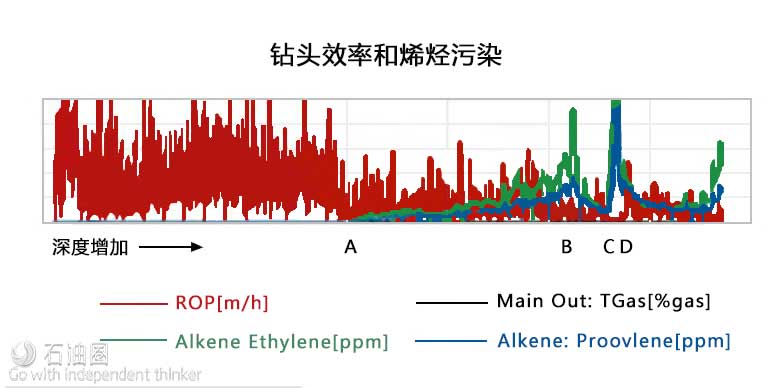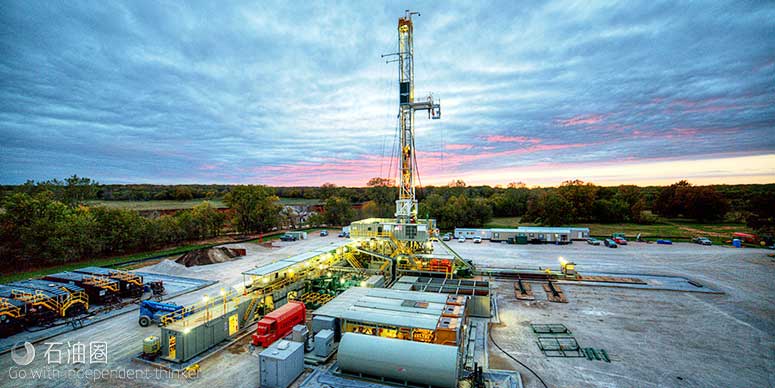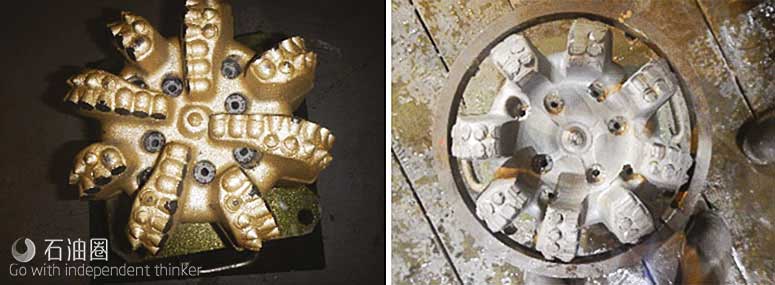GEOLOG’s BitLife real-time bit wear monitoring service applies a patent pending method to detect, compare and assess cuttings character, alkenes – the unsaturated hydrocarbons generated artificially by drilling fluid cracking, and drilling parameter responses such as torque and rate of penetration, to indicate the condition of the bit and its remaining drilling efficiency. Software provides objective commercial guidance for optimal timing of bit trips.
Benefits
1.Operational and economic indicators for when to pull the bit
2.Validates appropriate bit selection for the formation being drilled
3.Avoid invisible Non-Productive Time (NPT) through unnecessarily slow ROP
4.Avoid Non-Productive Time (NPT) by preventing junk or under-gauge hole
5.Real-time bit condition indication, remaining bit life estimation, and probable drilling efficiency
Challenges and Solutions
Understanding when a bit is nearing its end of life due to wear compared to a decrease in performance due to lithology change or other drilling dysfunction such as balling can be a major challenge, especially when the time to round-trip for a bit change can have a significant impact on well construction costs.
GEOLOG’s BitLife service provides decision-makers with timely information about bit condition based on alkenes generated by excessive friction from a worn bit. Increased alkenes, associated with low Rate of Penetration (ROP) and metamorphosed cuttings, is indicative of potential bit wear. This unique methodology provides a clear and concise indicator of the nearing end of effective bit life. It is a low cost real-time surface solution that helps ensure drilling operations and well delivery are as efficient and cost effective as possible.
Applications
BitLife works with Oil Based Muds (OBM), Synthetic Based Muds (SBM) and Water based muds that have hydrocarbon-based additives where thermal cracking of the drilling fluid hydrocarbon components can occur. This service is available for both offshore and onshore operations and can be run in any standard GEOLOG surface logging cabin.
Case Study 1
A major E&P operator in Sub-Sahara Africa utilizing a deep-water rig for an exploration campaign. Drilling was done using with synthetic oil based muds.
The operator was faced with periods of very slow drilling and was reliant on standard surface readings to try to determine if the drill bit was still performing. Being an exploration well, it was difficult to assess if the low ROP was caused by a lithological change or if the bit was no longer functioning. Any round trip to verify or replace the drilling bit took five (5) days.
As the client was utilizing a synthetic oil based mud, if the low ROP was due to the bit being worn, then it was highly likely that “bit burn” would be evident. Deploying GEOLOG’s “BitLife” service would enable the surface detection of the alkenes associated with this phenomenon and thus confirming a worn bit.
The “BitLife” service was deployed and a direct correlation was observed between the presence of alkene gas contamination (ethylene and propylene) and the low rates of penetration. The bit was removed after this correlation was seen for a period of time and the bit was found to be extremely worn and damaged. Thus, it confirmed the interpretation of the “BitLife” service. Subsequent bit runs were then performed utilizing the results from the “BitLife” service as the key indicator as to when a bit trip was necessary.
The improved bit trip efficiency resulted in a client-estimated savings of $15M USD. This was calculated based on the reduced number of bit trips required (no longer were ‘verification’ trips necessary) and by eliminating the time previously spent drilling with over-worn bits.
Confirming that worn drilling bits are the reason for low ROPs
With bit trips taking approximately five days of rig time, it was essential that the operator was only making bit trips when necessary. Slow ROPs were experienced but it could not conclusively be proven that it was due to bit wear. The only method available to confirm this was a time-consuming and expensive bit trip.
GEOLOG’s “BitLife” service allows for the surface monitoring of drill bit metamorphism or “bit burn” effects in near real-time
The “bit burn” effect occurs when bit wear reduces the cutting action of the drill bit and, therefore, increases the frictional effects. This then generates increased levels of heat which can cause temperatures at the bit to rise to as high as 800°C. At these elevated temperatures, alkene gases are produced due to the cracking of the hydrocarbons within the drilling fluid (OBM, SBM, or WBM with oil-based additives). The “BitLife” service monitors the presence of these gases in order to complement the traditional surface readings (such as ROP and Torque) to provide an over-all picture to the drilling team which allows for optimal decisions to be made in regards to bit trips.
Case Study 2
Kuwait Oil Company Onshore Development, Kuwait WBM with diesel added & OBM
Kuwait Oil Company required an accurate system to detect the bit condition and optimize drilling parameters for more efficient drilling. Their aim was to reduce the NPT resulting from unnecessary bit trips.
GEOLOG’s BitLife service was deployed to identify when the Drill Bit efficiency deteriorates due to bit wear. Drilling parameters were optimized to ensure drilling efficiently and trips performed at the correct time.
The service was deployed with both WBM (with diesel added) and OBM drilling fluids. Drilling parameters were optimized to get maximum footage and to effectively detect the condition of the drilling bit to determine the optimal time to perform bit trips. This data was utilized to study the efficiency of various bits with different drilling parameters.
The BitLife service was utilized to optimize drilling efficiency and detect the most efficient time to perform bit trips to avoid bit wear related NPT. By utilizing BitLife the client improved bit utilization, reduced valuable rig time by avoiding unnecessary bit trips, reduced the risk of bit related junk in hole thus avoiding associated costs of NPT.
BitLife service was implemented to effectively monitor bit wear and avoid NPT.
When drilling deep HPHT wells, bit efficiency is a concern for the drilling team. An onshore exploratory deep HPHT well in Kuwait required a technique to detect the condition of the bit in real-time to avoid losing the bit or parts of bit in hole and avoid drilling under-gauge hole due to excessive bit wear.
BitLife measures the presence of artificially generated gases in the well. While drilling, “Drill-Bit metamorphism” generates alkene gases through the cracking of hydrocarbon components of the drilling fluid system at high temperatures. These high temperatures are generated when drill bits lose their cutting action and friction becomes the more dominant effect.
The BitLife service was deployed in the 22” hole section and bit wear was detected with the presence of Alkenes, which was confirmed in this first run by a drop in ROP and an increase in Torque, which is easily seen in the bit condition once removed from the hole. In the 16” hole section, once the Alkenes were detected, indicative of a wearing bit, the bit was pulled out of hole, showing some chipped teeth, but still in gauge.


 石油圈
石油圈

